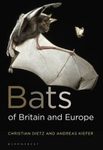Call us (08:30-16:00 UK)
+44 (0) 1803 86 59 13International
+44 (0) 1803 86 59 13Brauchen Sie Hilfe?
HilfeWichtiger Hinweis für Kundinnen und Kunden aus den USA
Datenerfassung und Monitoring
- Aquatic Survey & Monitoring
- Professional Hand & Kick Nets
- Water Testing
- Waders & Aquatic Safety
- View All
- Amphibian & Reptile Survey
- Amphibian Survey & Monitoring
- Reptile Survey & Monitoring
- Scales, Balances & Holding Bags
- View All
Feldführer und Naturgeschichte
Akademische und professionelle Bücher
- Evolutionary Biology
- Evolution
- Human Evolution & Anthropology
- Cladistics, Phylogeny & Taxonomy
- View All
British Wildlife
British Wildlife is the leading natural history magazine in the UK, providing essential reading for both enthusiast and professional naturalists and wildlife conservationists. Published eight times a year, British Wildlife bridges the gap between popular writing and scientific literature through a combination of long-form articles, regular columns and reports, book reviews and letters.
Conservation Land Management
Conservation Land Management (CLM) ist ein Mitgliedermagazin und erscheint viermal im Jahr. Das Magazin gilt allgemein als unverzichtbare Lektüre für alle Personen, die sich aktiv für das Landmanagement in Großbritannien einsetzen. CLM enthält Artikel in Langform, Veranstaltungslisten, Buchempfehlungen, neue Produktinformationen und Berichte über Konferenzen und Vorträge.

























![Fotoatlas der Amphibienlarven Deutschlands, Österreichs und der Schweiz [Photographic Atlas to the Amphibian Larvae of Germany, Austria and Switzerland]](http://mediacdn.nhbs.com/jackets/jackets_resizer_medium/24/249577.jpg?height=150&width=101)
![Bioakustik der Froschlurche: Einheimische und Verwandte Arten [Bioacoustics of Frogs: Native and Related Species]](http://mediacdn.nhbs.com/jackets/jackets_resizer_medium/15/158996.jpg?height=150&width=107)
![Die Geburtshelferkröte: Brutpflege ist Männlich [The Midwife Toad: Brood Care is Masculine]](http://mediacdn.nhbs.com/jackets/jackets_resizer_medium/20/203612.jpg?height=150&width=104)
![Das Mauswiesel in der Kulturlandschaft Südwestdeutschlands: Abundanz, Reviersysteme und Habitatnutzung [The Weasel in the Cultivated Landscape of South West Germany: Abundance, Ground Systems and Habitat Use]](http://mediacdn.nhbs.com/jackets/jackets_resizer_medium/20/201998.jpg?height=150&width=106)
![Steinmarder in Unterschiedlichen Lebensräumen: Ressourcen, Räumliche und Soziale Organisation [Stone Marten in Different Habitats: Resources, Spatial and Social organization]](http://mediacdn.nhbs.com/jackets/jackets_resizer_medium/14/147969.jpg?height=150&width=108)
![Die Westpaläarktischen Wasserfrösche: Von Märtyrern der Wissenschaft zur Biologischen Sensation [The Western Palearctic Water Frogs: From Martyrs of Science to Biological Sensation]](http://mediacdn.nhbs.com/jackets/jackets_resizer_medium/16/160936.jpg?height=150&width=106)
![Die Blindschleiche: Die Vergessene Echse [The Slow Worm: The Forgotten Lizard]](http://mediacdn.nhbs.com/jackets/jackets_resizer_medium/17/170392.jpg?height=150&width=115)
![Die Amphibien und Reptilien der Südwest-Türkei [The Amphibians and Reptiles of Southwest Turkey]](http://mediacdn.nhbs.com/jackets/jackets_resizer_medium/20/209270.jpg?height=150&width=105)
![Die Kreuzotter: Ein Leben in Ziemlich Festen Bahnen [The Common European Viper: A Life in Quite Fixed Ways]](http://mediacdn.nhbs.com/jackets/jackets_resizer_medium/25/252232.jpg?height=150&width=109)
![Amphibien Bestimmen am Land und im Wasser [Identifying Amphibians on Land and in Water]](http://mediacdn.nhbs.com/jackets/jackets_resizer_medium/24/242891.jpg?height=150&width=108)
